..... Fire Engines!!!!
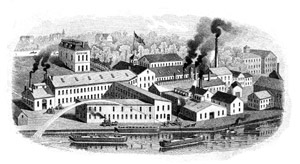 island
in the Seneca River, in Seneca Falls. Silsby originally manufactured
agricultural implements. Once fire engine construction started,
and the factory expanded, the chief products of the Island Works
became steam fire engines, hose carriages, hose carts, hose wagons,
and Holly rotary pumps,
island
in the Seneca River, in Seneca Falls. Silsby originally manufactured
agricultural implements. Once fire engine construction started,
and the factory expanded, the chief products of the Island Works
became steam fire engines, hose carriages, hose carts, hose wagons,
and Holly rotary pumps,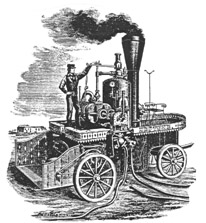 Silsby
was a true pioneer in the business of supplying the world with
machinery capable of doing work never imagined by inventors just
a few years previously. The first Silsby steamer, built in 1856
was one such machine. This firet experimental engine weighed nearly
10,000 pounds, and compared with later steamers was indeed a curiocity;
and yet, within its crude lines, contained all the points of excellence
which, by modification, have garned this successful firm a place
in the history of steam fire engines.
Silsby
was a true pioneer in the business of supplying the world with
machinery capable of doing work never imagined by inventors just
a few years previously. The first Silsby steamer, built in 1856
was one such machine. This firet experimental engine weighed nearly
10,000 pounds, and compared with later steamers was indeed a curiocity;
and yet, within its crude lines, contained all the points of excellence
which, by modification, have garned this successful firm a place
in the history of steam fire engines.With the construction of their first engine in 1856, Silsby became one of the first manufacturers of steam fire engines. During the steam era Silsby built more steam fire engines than any other manufacturer, building well over 1000 machines.
The Silsby engine was constructed entirely using original and novel principles. For years it was condemned by theorists, machinests, and engineers, who were wedded to the piston or reciprocating system of engine and pumps. The pumps and engines of the Silsby machines were known as the rotary type, and made to Mr. Birdsall Holly's patent. Silsby worked diligently over the years to imporve thier pumps and engines, until finally by the end of the steam era, unprejiduced experts agreed that the rotary pump was the finest fire pump in the world.
In addition to Mr. Holly, at the time of the building of the first engine, Silsby also had Mr. M. R. Clapp, inventor of the drop tube boiler in their employ. Mr. Clapp later headed Clapp and Jones Mfg., another successful manufacturer of stea
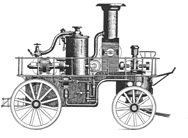 m
fire engines.
m
fire engines.Early records show that Silsby constructed a second model between 1857 and 1860 which somewhat resembled the first. It is not known that any of these very early engines survive today, nor it it known which builders numbers related to them. The illustration to the left shows this model. With the arrival of the third model some time in 1860, the engines took on a shape that would resemble engines produced through 1874. It is believed that one of these
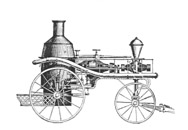 early
engines may exist today. It is number 28 which was built for Columbus,
Ohio. This engine was built in 1860, beyond that little is known
about it, and its location at this time is somewhat in question.
early
engines may exist today. It is number 28 which was built for Columbus,
Ohio. This engine was built in 1860, beyond that little is known
about it, and its location at this time is somewhat in question.In the early years Silsby was working diligently to improve their engines, to this end, models changed frequently. A fourth model appeared some tim
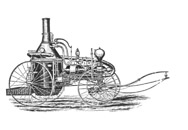 e in
1862. It's numerous changes were both functional and asthetic.
It is not known exactly how many engines of this model were built,
but builder's numbers probably ranged from around 60 into the
80's. One of these engines is known to exist today. It is #39,
a first size unit built for Marysville, CA, and still owned by
that fire department. This is one of the oldest known surviving
steam fire engines in the country. The fifth model appeared in
1864 and continued in production for about one year. Numbers for
e in
1862. It's numerous changes were both functional and asthetic.
It is not known exactly how many engines of this model were built,
but builder's numbers probably ranged from around 60 into the
80's. One of these engines is known to exist today. It is #39,
a first size unit built for Marysville, CA, and still owned by
that fire department. This is one of the oldest known surviving
steam fire engines in the country. The fifth model appeared in
1864 and continued in production for about one year. Numbers for
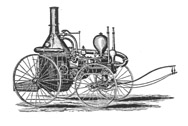 these engines probably
ranged from around 60 to the early 80's. There is no record of
any of these engines existing today. In 1865 a new model, the
sixth was intrtoduced. In appearance, this model closely resembled
the two previous engines. Builder's numbers probably ranged from
around 80 to about 100. None of these engines are known to survive
today.
these engines probably
ranged from around 60 to the early 80's. There is no record of
any of these engines existing today. In 1865 a new model, the
sixth was intrtoduced. In appearance, this model closely resembled
the two previous engines. Builder's numbers probably ranged from
around 80 to about 100. None of these engines are known to survive
today.The seventh
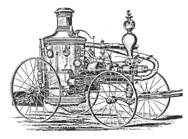 model was introduced
in 1866 and built through 1868. The appearance of this engine
was quite a departure from earlier engines, as it took on a resemblence
to all future engines. Builder's numbers ranged from around 100
to about 180. Though none of these engines are known to exist
today, with so many built, one can hope that one day one will
appear from the dusty corner of an old barn somewhere.
model was introduced
in 1866 and built through 1868. The appearance of this engine
was quite a departure from earlier engines, as it took on a resemblence
to all future engines. Builder's numbers ranged from around 100
to about 180. Though none of these engines are known to exist
today, with so many built, one can hope that one day one will
appear from the dusty corner of an old barn somewhere.In 1869 Silsby introduced their eighth model. It was to be the final design with a straight frame. Production of this model continued through 1874, and the numbers ranged from around 200 to 490. Quite a few of these engines exist today with examples from each year of manufacture. No. 483, belonging to Protection Engine Company No. 3, Honesdale PA, a 3rd size 1874
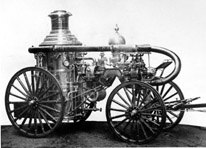 is
at this time the only known operable engine.
is
at this time the only known operable engine.The Model of 1875 was the last major model change. There are several variations of this ninth model engine. Builder's numbers ranged from just below 500 to 3109. At least 40 of these "modern" Silsby engines are known to exist. Some of them are operable, and more will probably appear as interest in them increases. The last engine actually built by Silsby Manufacturing Co. was No. 1015 built for Jacksonville, IL in 1891. In December 1891, Silsby merged with Ahrens Manufacturing Co., Clapp & Jones Manufacturing Co., and Button Fire Engine Company, to form American Fire Engine Company. American introduced their own line of steamers. Demand was so strong for Silsby engines that they continued to produce them, with nearly 100 additional Silsby engines manufactured before the end of the steam era. Next to the last engine produced, # 3033, a 5th sixe unit built in 1905 for Nicholson, PA is still owned by that fire department.
No comments :
Post a Comment